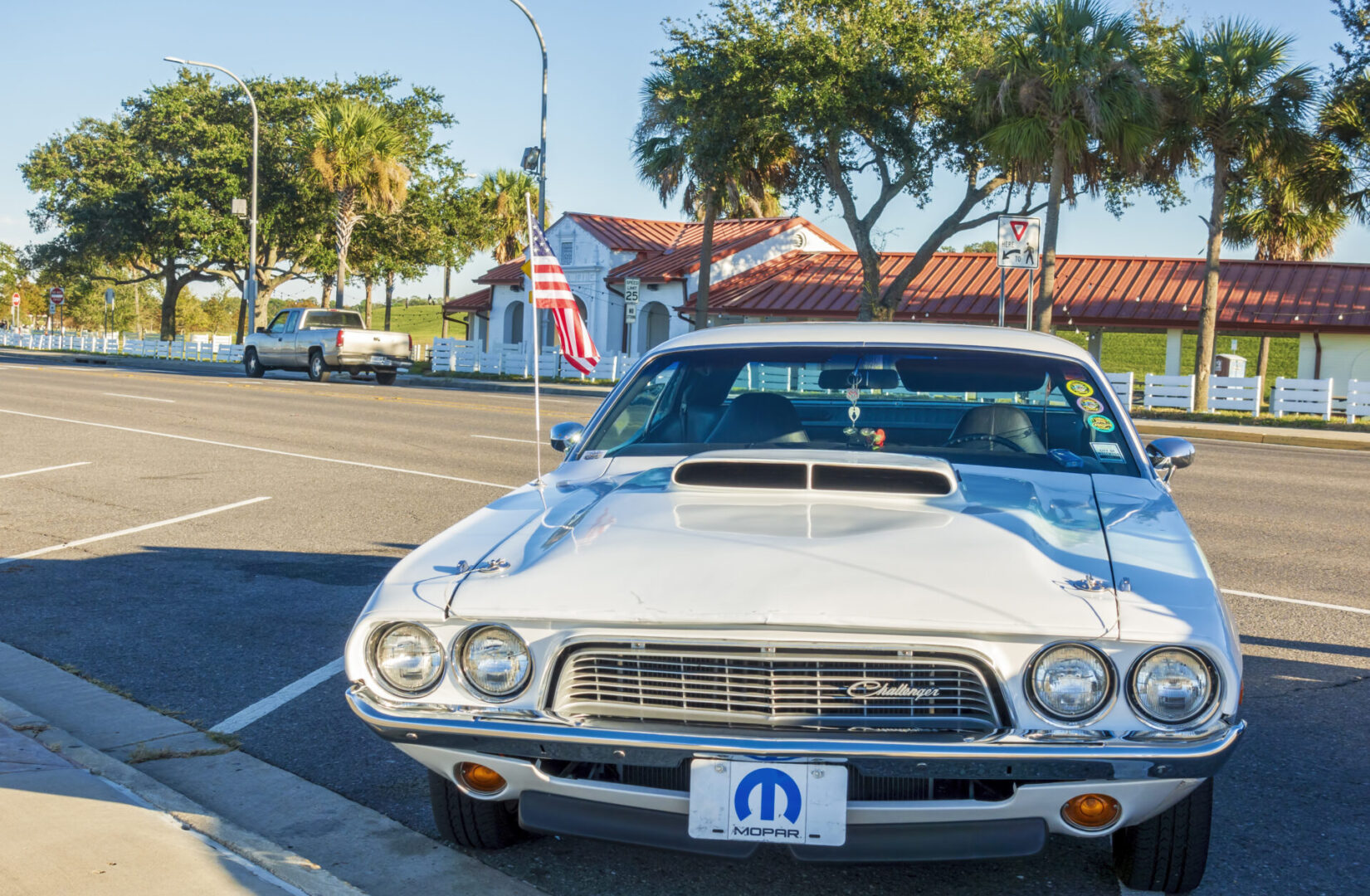MOPAR OR NO CAR: MUSCLE CAR MANIA

Mopar is a term used to describe muscle cars produced by Chrysler Corporation. These cars were known for their powerful engines and sleek designs, and driving one meant embracing a certain lifestyle. For Mopar enthusiasts, every stoplight was an opportunity to rev the engine and feel the rush of speed. The addiction to the rumble and power of these cars created a community of speed fanatics who shared a passion for high-performance vehicles.
Mopar, a division of Chrysler, played a significant role in the muscle-car movement that began in 1955 with the introduction of its powerful 300-horsepower Hemi V-8 engine. As the 1960s rolled around, major automakers were competing to produce the fastest and most impressive muscle cars on the market. However, many car enthusiasts consider the late 1960s and early 1970s to be the golden age of Mopar, with Dodge, Chrysler, DeSoto, Imperial, and Plymouth producing eye-catching, rubber-burning muscle cars. These cars, such as the 1968 Charger from "Bullitt" and the white 1970 Dodge Challenger R/T from "Vanishing Point," became iconic stars of the big screen. The engines that powered these legendary vehicles continue to be celebrated today.
276 FirePower Hemi V8
In 1951, Chrysler introduced the FirePower Hemi V8 engine, which utilized a hemispherical combustion chamber design and produced 180 horsepower. Other brands under the Chrysler umbrella, such as Dodge, DeSoto, and Imperial, also had their own versions of the Hemi engine. Most FirePower engines had a bore-spacing of 4.5625 inches and were equipped with a two-barrel carburetor. However, the 1955 Chrysler C-300 boasted dual Carter WCFB four-barrel carburetors and an impressive 300 horsepower, making it a standout in its time. The FirePower Hemi engine also served as the foundation for the second-generation Hemi engine, which will come later.
383 B-Engine V-8
The 383 B-Engine V-8 was introduced by Chrysler in 1958 as a replacement for the first generation of FirePower Hemi engines. With a bore of 4.25 inches and a stroke of 3.375 inches, the 383 was the most powerful B-engine and generated power through high rpm. This made it a more popular option than the larger, but lower-revving, 426 Hemi or 440. By 1970, the 383 Magnum had a peak output of 335 hp and 425 lb-ft of torque. It was used in a variety of Mopar muscle cars, including the Dodge Charger and Plymouth 'Cuda
413 Max Wedge V8
The Chrysler 413 engine was a powerful Mopar engine that was introduced in 1959. It had a 4.18-inch bore and 3.75-inch stroke and was initially used in luxury cars. However, in 1962, the 413 was reworked into a high-performance engine called the 413 Max Wedge. This limited-production engine had a displacement of 425 cubic inches and featured solid lifters, dual-valve springs, magnafluxed rods, and shortram induction manifolds. With an 11.0:1 compression ratio, the 413 Max Wedge had an impressive output of 415 hp and 470 lb-ft of torque. Its unique combustion chamber shape gave it its name, and it quickly became a favorite among muscle car enthusiasts.
426 Max Wedge
In 1963, the 426 Max Wedge engine was introduced as a larger version of the RB engine. It boasted a 4.25-inch bore and three compression ratios, ranging from 11.0:1 to 12.5:1 depending on the configuration. The "Stage III" version of the 426 Max Wedge was particularly impressive, featuring high-flow cylinder heads, improved oil feed, a cross-ram intake manifold, two Carter 4-barrel carburetors, and a high-flow cast-iron exhaust manifold. With a factory-rated 425 horsepower and 480 lb-ft of torque, it quickly became a favorite among high-performance enthusiasts and remained so until the introduction of the 426 Hemi.
426 Hemi V-8
The 426 Hemi V-8 engine is widely considered to be one of the most significant V8 engines ever produced. It revolutionized the muscle car industry by setting new standards for power and performance that are still admired today. The engine was created by combining two different engines - the 426 Max Wedge and the hemispherical-head technology from the 1950s Chrysler FirePower Hemi. It dominated the 1964 racing season, including the Daytona 500 where it claimed the top four spots, and became legendary in cars like the Dodge Charger and Pontiac GTX. However, NASCAR banned the engine from competition until it was approved for production, causing Chrysler to sit out the 1965 NASCAR season while they designed a street version. Despite this setback, the engine continued to thrive in the NHRA* and gave rise to a new generation of advanced, hemi-headed engines that are still used today.
The 426 Hemi V-8 engine was a powerhouse that was originally designed for racing. However, to make it street legal, Mopar had to make some adjustments. They lowered the compression ratio from 12.5:1 to 10.25:1, used cast-iron heads instead of aluminum. They also made changes to the intake and exhaust manifolds. The engine was advertised at 425 hp and 490 lb-ft of torque, but it was rumored to generate even more power. The Dodge Daytona, powered by the 426 Hemi, became the first production car to reach 200 mph on a closed circuit. The engine was a popular choice for muscle cars like the Plymouth Road Runner, Plymouth Superbird, and Dodge Charger, but it came with a hefty price tag. Only around 11,000 production Hemis were made, which is why they are highly sought after and can fetch seven figures at auction today.
Chrysler 440 V-8
The Chrysler 440 V-8 engine is a legendary muscle-car engine that was the last version of the B-engine. While not as rare or exotic as the 426 Hemi, the 440 was still a powerful engine that delivered similar performance at a more affordable cost. It was designed with a precision cast-iron block, iron heads, and a round bore of 4.32 inches with a 3.75-inch stroke. The "Six-Pack" configuration, which included a 10.3:1 compression ratio and an aluminum Edelbrock manifold topped with three Holley 2300 series carburetors, allowed the 440 to produce 390 horsepower and 490 lb-ft of torque during the 1969 to 1971 model years. It was a standard feature in high-performance models such as the Dodge Charger R/T, Dodge Coronet R/T, and Plymouth Belvedere GTX. It was also available as an option in other popular muscle cars like the Dodge Super Bee and Plymouth Road Runner. With its impressive power and torque, the 440 V-8 helped these cars achieve legendary status among car enthusiasts.
Protect Your Mopar Muscle
For those who are fortunate enough to own a Mopar muscle car with a powerful V8 engine, protecting your investment is essential. To ensure your classic car can continue to dominate the streets for years to come, consider using AMSOIL products. These high-quality products are designed to provide the ultimate protection for your engine and keep your Mopar running smoothly.
AMSOIL Break-In Oil
When it comes to breaking in a newly rebuilt engine, using AMSOIL Break-In Oil is highly recommended. This specially formulated oil contains anti-wear additives like zinc and phosphorus, which provide crucial protection to the engine's components during the initial break-in period when wear rates are at their highest. Additionally, this oil doesn't contain friction modifiers, which allows for efficient and speedy piston-ring seating. This is a crucial step in the break-in process, as it ensures maximum power and longevity for your engine.
AMSOIL Z-ROD® Synthetic Motor Oil
AMSOIL Z-ROD® Synthetic Motor Oil is the perfect choice for classic and high-performance vehicles. This specially engineered oil is designed to provide superior protection on the street and during storage. Its high-zinc formulation protects flat-tappet camshafts and other critical engine components, while a unique blend of rust and corrosion inhibitors provides added protection during long-term storage. Available in 10W-30, 10W-40, and 20W-50 viscosities, AMSOIL Z-ROD® is the ultimate choice for your prized possession.
AMSOIL Assembly Lube
When building a high-performance engine, it's important to use the right lubricant to ensure longevity and optimal performance. AMSOIL Assembly Lube is specifically designed for partially assembled engines that may sit idle for extended periods of time. This specialized lubricant clings to engine parts, providing wear protection, rust inhibition, and preventing deposit formation. With AMSOIL Engine Assembly Lube, you can rest assured that your engine will be protected during the critical assembly process.
Miracle Wash® Waterless Wash and Wax Spray
For car owners who want to maintain their vehicle's appearance as well as its performance, the AMSOIL Miracle Wash® Waterless Wash and Wax Spray is a game-changer. With just a simple spray and wipe, this product can instantly remove dirt from the surface of your car. Not only does it leave your car looking super shiny, but it also provides protection against dust, light dirt, and harmful ultraviolet rays. Say goodbye to the hassle of traditional car washing and hello to a quick and easy solution with Miracle Wash®.
AMSOIL Gasoline Stabilizer
AMSOIL Gasoline Stabilizer is a must-have for anyone looking to store their vehicle for an extended period. Gasoline can start to break down in as little as a month, leading to poor engine performance and potential damage. By treating your fuel tank with AMSOIL Gasoline Stabilizer before storing your vehicle for the winter, you can help prevent fuel degradation and ensure your ride is ready to hit the road come springtime.
DOMINATOR® Octane Boost
Classic and collector cars were designed to run on leaded gasoline, which is no longer available. To preserve the original components of these vehicles, a lead substitute is necessary. AMSOIL DOMINATOR Octane Boost is a great option for older cars as it can increase octane levels by up to four points, reducing engine knock and improving ignition. Additionally, it helps fuel burn more cleanly, making it a great choice for those looking to maintain the performance of their classic cars.
Engine Fogging Oil
To prevent rust, corrosion, and harmful dry starts, it's important to treat any engine facing storage or lengthy inactivity with Engine Fogging Oil. By giving the cylinders a shot of oil, you can protect your hot rod or classic car and ensure it's ready to fire up the following season.










